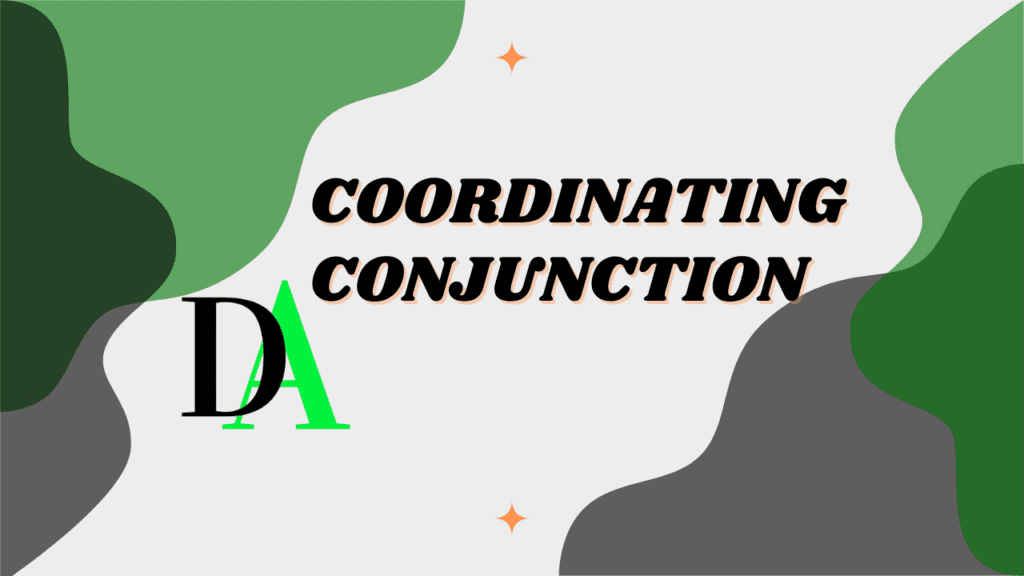what is coordinating conjunction?
A coordinating conjunction is a short word which is used to connect two or more words, phrases or clauses of same grammatical type or equal importance within a sentence.
Before we dive deeper, let’s quick look at the most well-known dictionaries define coordinating conjunction. This will help us build a clear understanding from reliable resources.
Definition of coordinating conjunction
Oxford learner’s dictionary defines as “a word such as or, and or but, that connects clauses or sentences of equal importance.” Merriam website dictionary also defines a coordinating conjunction as “a conjunction (such as and or or) that joins together words or word groups of equal grammatical rank.” Collins dictionary defines a as “ a word such as ‘and,’ ‘or,’ or ‘but’ which joins two or more words, groups, or clauses of equal status, for example two main clauses.”
What is FANBOYS?
FANBOYS is an easy way to remember 7 coordinating conjunction in English.
F – for
A – and
N – nor
B – but
O – or
Y – yet
S – so
“For” is used to give a reason similar to “because.” For example, he stayed home because she was tired.
And is used to add one idea together; for example, I like mangoes and apples.
“Nor” is used to add another negative idea to a sentence that already has a negative,for example, He doesn’t like rice, nor does he like pasta.
“But” is used to show a contrast or difference between two ideas. For example, we want to play, but it started raining.
“Or” is used to show a choice between two things; for example, do you want tea or coffee?
“Yet” is similar to “but” and shows contrast or surprise; for example, it’s cold, yet he is not wearing a jacket. Lastly,
“So” it shows a result or effect. For example i was late, so I went to bed.
Are we can see Coordinating are small words that help connect ideas and make sentences clear and smooth in English.
Coordinating conjunction examples
Here are some examples of 7 coordinating conjunctions
- She stayed at home, for it was raining heavily.
- We visited the museum, and we explored the city park afterward.
- She didn’t like the film, nor did she enjoy the popcorn.
- I enjoy cooking, but I really have time for it.
- You can start the project today, or you can wait until Monday.
- He worked very hard, yet he didn’t pass the exam.
- The road was closed, so we took a different route.
Coordinating conjunction join two words
Coordinating are conjunction that can join single words of the same type. These must match grammatically (noun to noun, adjective to adjective, verb to verb, etc.).
Example
Two nouns
She bought a book and a pen.
Lions and tigers can be found in the forest.
Two verbs
Maria wrote and read the lesson.
Ahmed can stay or leave whenever he wants.
Two adjectives
Her dress was clean and new.
The bag was big and light.
Two adverbs
She moved slowly but gracefully.
He worked quietly and efficiently.
When the coordinating joinning two words, no comma is needed before the conjunction.
Coordinating conjunction join two phrases
Coordinating conjunctions can also join phrases such as adjective phrases, noun phrases, prepositional phrases, verb phrases, etc.
Note: we will write the coordinating conjunction as bold and italic for the phrases that are joined.
Look at the examples below; the coordinating conjunction is joining two adjective phrases.
The cat is very small and very cute.
My bag is full of books but easy to carry.
As you can see, the coordinating conjunction, which is “and” joins two adjective phrases.
Here the coordinating conjunction is joining two adjective phrases.
In the next example, the coordinating conjunction is linking two noun phrases together.
I like tea with milk and rice with meat.
In the examples above, conjunction “and” linked two noun phrases.
Sometimes the coordinating conjunction can join two prepositional phrases, as you can see in the example below:
The pen is under the table or on the bed.
The coordinating, which is “or” joined two prepositional phrases together.
The coordinating conjunction can join two verb phrases to make complete sense. Look at the examples below.
She is writing the book and listening to the music. Here the coordinating conjunction linked two verb phrases.
Coordinating conjunctions join independent clauses
An independent clause is a clause that can stand alone as a simple sentence. When two independent clauses are logically closely related, it often makes sense to combine them into a compound sentence with the help of a coordinating conjunction and a comma.
Look at the examples below; a coordinating conjunction joins two clauses.
I missed the bus, so I decided to walk to the market.
The sun was shining brightly, for the rain had stopped earlier.
They searched the entire house, yet they couldn’t find the missing keys.
Maria wanted to join the hiking trip, but she had too much work to finish.
In these examples the coordinating conjunction is joining two clauses together.
4 important rules for using coordinating conjunctions correctly
Of course! Here is an elaboration for every important thing to keep in mind when it comes to using coordinating conjunctions:
1. Join equal ideas using conjunctions.
Parts of a sentence that have equal grammatical value can be joined using coordinating conjunctions. For example, two independent clauses (complete sentences). Also two nouns, adjectives, or verbs. Adding conjunctions makes the sentences clearer. For example:
I like coffee and tea. (Two nouns)
I went to the store, and I bought some fruit (two independent clauses).
2. Commas Should Only Be Used in Certain Instances.
As a rule of thumb, when two independent clauses are joined with coordinating conjunctions, a comma should be placed before the conjunction. This comma helps the reader by signifying the end of an idea and the start of another. Let’s take a look:
She studied hard, but she didn’t pass the exam.
This sentence without the comma can get tricky and hard to read.
3. Don’t use them to join dissimilar parts
Joining two sentences by using coordinating conjunctions will work best when at least one of the two parts is related by meaning or logically connected. Try to limit your ideas to only two at once. Otherwise, the sentence will become confusing or strange. For instance, using the following example is a lot more pleasant to hear:
I wish to go for a walk, but it is raining.
Rather than combining unrelated concepts, for example, I want to go for a walk, but I like pizza. (This example is vague and unclear.)
4. Avoid beginning too many sentences with coordinating conjunctions
In more formal texts, avoiding starting sentences with “and,” “but,” or “so” gives them a more polished feel. These words can be used as sentence starters for emphasis, but should not be relied on too frequently. In such cases, sentences can be merged to give a better flow. For example,
Less formal: And I went to the market, but I forgot my wallet.
More formal: I went to the market; however, I forgot my wallet.
Exercise: Choose the correct coordinating conjunction to complete each sentence
- I wanted to call you, _____my phone was dead.
- She didn’t see the sign, ____ she kept driving.
- We can watch a movie, _____ we can play a board game.
- He doesn’t like coffee, _____ does he like tea.
- I was hungry, _____ I made a sandwich.
- The weather was cold, _____ we went for a walk.
- They studied hard, _____ they failed the test.
- You can come with us, ____ you can stay at home.
- She loves painting, ______ she doesn’t like drawing.
- I bought a new book, ____ I haven’t started reading it yet.
- We went to the park, ____ it started to rain.
- He didn’t want to go, ____ he went anyway.
Answers:
- I wanted to call you, yet my phone was dead.
- She didn’t see the sign, but she kept driving.
- We can watch a movie, yet we can play a board game.
- He doesn’t like coffee, or does he like tea.
- I was hungry, nor I made a sandwich.
- The weather was cold, so we went for a walk.
- They studied hard, yet they failed the test.
- You can come with us, but you can stay at home.
- She loves painting, or she doesn’t like drawing.
- I bought a new book, but I haven’t started reading yet.
- We went to the park, but it started to rain.
- He didn’t want to go, but he went anyway.
Frequently Asked Questions (FAQs) on Coordinating Conjunctions
Q1: What are coordinating conjunctions?
Coordinating conjunctions are the words that connect equal elements of a sentence, i.e., two independent clauses, two words, or two phrases. The main coordinating conjunctions are for, and, nor, but, or, yet, and so.
Q2: When should I use a comma with coordinating conjunctions?
Place a comma before the coordinating conjunctions when it is linking two independent clauses (full sentences). Example: She was hoping to leave early, but the meeting lasted longer.
Q3: Can single words be joined by coordinating conjunctions?
Yes, single words like nouns or adjectives can be joined. Example: We bought apples and oranges.
Q4: Is it correct grammatically to start a sentence with a coordinating conjunction?
It is acceptable, especially when writing informally, to start a sentence with coordinating conjunctions like “and,” “but,” or “so,” but don’t overdo it in formal writing.
Q5: How are “but” and “yet” different from each other?
Both show contrast, but “yet” is used to stress an unexpected or surprising contrast. For example, he was tired, but he kept working. / He was tired, yet finished the project on time.
Q6: Can I omit commas with coordinating conjunctions?
You don’t need a comma to join simple words or phrases (not independent clauses). For example, she likes tea and coffee.
Read also
Difference between Coordinating conjunction and Subordinating conjunction

